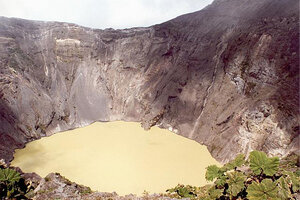Bizarre crystals reveal underground magma 'highway'
The deadly 1963-1965 eruption of Irazú contained lava that pushed through the earth's 20-mile thick crust in about a year, reveal crystals from deep below the Earth's surface. Conventional wisdom says magma needs hundreds or thousands of years to make the trip.

A lake occupies one of the summit craters of Irazú, one of Costa Rica's most active volcanoes. Irazú rises to 11260 feet (3432 m) near the capital city of San José and is the country's highest volcano. This crater lake, seen in 1996 from the southern crater rim, has been the source of many historical eruptions.
José Enrique Valverde Sanabria / Eduardo Malavassi / OVSICORI-UNA
Not all volcanoes are created equal. Sometimes magma screams upward – in the kimberlite tubes that bring diamonds to the surface, magma flies upward at over 800 miles per hour – but that's very unusual, and limited to small volcanoes. Most magma, especially in big volcanoes, is slow and steady – more tortoise than hare. Right?
Not necessarily, says Philipp Ruprecht, a volcanologist at Columbia University's Lamont-Doherty Earth Observatory in New York. "We like to call it the highway from hell," said his co-author Terry Plank, a geochemist at Lamont-Doherty, in a press release.
In an article published in today's Nature, Drs. Ruprecht and Plank describe fast-moving magmas not just in tiny volcanoes or kimberlite tubes, where it might be expected, but in a huge, long-lived volcano in Costa Rica.
"That's the interesting story, really, that such a fast transport mechanism exists even in these long-lasting, large stratovolcanic systems that are thought to operate on much longer time scales," says Ruprecht.
They examined Irazú, a massive volcano in Costa Rica. Reaching over 11,000 feet tall and spreading across 200 square miles, Irazú is the tallest volcano in Costa Rica, and one of the most active. It has erupted two dozen times in the past 300 years, most famously emerging from a 23-year dormant period to shower ash over President John F. Kennedy's visit to Costa Rica in March 1963.
"Typically, magma moves upward, usually by cracking the rocks above it and creating a space for the magma to go into," explains Ruprecht, "taking steady steps toward the magma chamber. In this study, it was a much more rapid ascent."
In other words, sometimes it skips the long trip up the stairs in favor of the express elevator to the penthouse.
This could have important implications for volcano prediction, which is still more art than science. If magma is rising through the crust less than a year before the eruption, that means that tracking the movement could help scientists warn of an imminent eruption.
Unfortunately, the earthquakes caused by magma tend to be very small, only magnitude 1 or 2, and very, very deep – miles below the surface. The global earthquake system is better at catching big, shallow earthquakes, around magnitude 3 or higher, says Ruprecht. It's a princess-and-the-pea problem: tiny, deep earthquakes can only be felt by very, very sensitive equipment located on the flanks of the volcano itself.
Decoding the secret of the speed
When Ruprecht and Plank looked at the lava and ash from the 1963-1965 eruption of Irazú, nothing waved a flag saying, "Hey, I was in the mantle just last year." So how did Ruprecht and Plank figure it out?
They were looking at tiny olivine crystals that had grown, layer by layer, incorporating information about the environment, just like a growing tree stores information about the climate in each year's tree ring. But there's a problem with the tree-ring analogy, says Ruprecht: "If you look at two trees next to each other, they do record the same climate, versus if you look at two crystals next to each other, they might record very different parts of the story."
"Think about 1,000 people who attend an opera. Everyone sees the same play – or, in our case, the crystals experience the same kinds of processes below the surface. Some are very close to the action and they might see that the opera singer had a bad day, while other people in the back thought it was great. Some people fall asleep, and they might miss half of it," says Ruprecht. "Everyone saw something, but they didn't quite see the same thing."
In this study, they were looking for the crystals that started growing as deep in the earth as possible – potentially even down in the mantle. "So just a few crystals are going to tell us that, like the front-row people in the theater. If you really want to understand what happened right on the stage, you have to ask someone very close to the stage."
And you have to ask them soon. Just like time can fade the details of a memory, crystals can lose their recorded chemical signatures as they climb the 20 miles (35 km) through the earth's crust.
But these olivine crystals still had sharp chemical "memories" of life in the mantle, telling Ruprecht that they'd ascended very, very quickly.
"The conventional wisdom is that these magmas are typically leaving the mantle and moving all the way to the surface over hundreds to thousands of years. I'm actually not disagreeing with that general statement. What we found at Irazú is that large volcanoes also have this 'fast mode,' " Ruprecht explains.
To have such sharp memories of the mantle, these magma crystals had to have moved through the crust in months or years, traveling at least 10 feet per hour – and maybe faster, though they'll need to take more measurements to better constrain the speed.
And it's not limited to Costa Rica. His research team has also looked at volcanoes in the Aleutian Islands, the Tonga trench, in Chile, even Mount Pinatubo. "There's quite a few volcanoes that have this 'fast track' to the surface," says Ruprecht.

